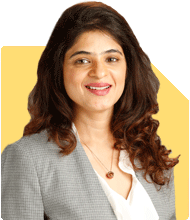Young Woman Aims for 5 Lakh Investment: Best SIP Options?
Ramalingam Kalirajan |8459 Answers |Ask -Follow
Mutual Funds, Financial Planning Expert - Answered on Jul 15, 2024
He has an MBA in finance from the University of Madras and is a certified financial planner.
He is the director and chief financial planner at Holistic Investment, a Chennai-based firm that offers financial planning and wealth management advice.... more

I am 24, female. My monthly stipend is 17,400 for the next 2 yrs. I want to invest 50% of it in SIPs so that after 2 yrs I have a balance to get into a investment. Please suggest me type of SIP or plans, also how to consider risk factors associated. Kindly also discuss ideal amount I must invest monthly to obtain a lumpsum of 5 lacs, if possible.
Systematic Investment Plans (SIPs)
Types of SIPs
1. Equity Mutual Funds SIPs
Equity mutual funds invest primarily in stocks. They offer the potential for high returns but come with higher risk. Suitable for investors with a higher risk appetite, these funds are ideal for long-term goals.
2. Debt Mutual Funds SIPs
Debt mutual funds invest in fixed-income instruments like bonds and treasury bills. They offer lower returns compared to equity funds but come with lower risk. These funds are suitable for short-term goals and conservative investors.
3. Hybrid Mutual Funds SIPs
Hybrid mutual funds invest in a mix of equity and debt instruments. They offer a balanced approach, providing moderate returns with balanced risk. These funds are suitable for investors seeking a mix of growth and stability.
Choosing the Right SIP
Given your goal to accumulate Rs 5 lakhs in 2 years, it's crucial to balance potential returns with risk. Considering the relatively short investment horizon, a mix of equity and debt funds might be ideal. Hybrid mutual funds could provide a good balance of growth and safety.
Calculating the Required Investment
Estimating SIP Amount for Rs 5 Lakhs in 2 Years
To accumulate Rs 5 lakhs in 2 years, let's estimate the monthly SIP investment required. We will consider an average annual return of around 10%, which is a moderate estimate for a balanced portfolio.
Based on a simplified formula, the required monthly SIP investment can be estimated as follows:
• Future Value (FV) = Rs 5,00,000
• SIP Amount = Monthly investment
• r = Monthly rate of return (approx. 0.0083 for 10% annual return)
• n = Number of months (24 months)
Using this formula, you can calculate the exact amount. However, for a quick approximation, investing Rs 8,700 monthly could potentially help you reach your goal, considering a moderate return rate.
Risk Factors and Management
Understanding Risk
Investment in mutual funds involves market risk. The value of your investments can fluctuate based on market conditions. Understanding the risk associated with different types of funds is crucial.
Equity Fund Risks
• Market Risk: The value can fluctuate significantly.
• Sector Risk: Performance can be impacted by specific sectors.
Debt Fund Risks
• Interest Rate Risk: Value can be affected by changes in interest rates.
• Credit Risk: Risk of default by issuers of the debt instruments.
Hybrid Fund Risks
• Balanced Risk: Combination of equity and debt risks.
Managing Risk
1. Diversification
Invest in a mix of equity and debt funds to spread risk.
2. Regular Monitoring
Review your investment portfolio regularly. Adjust based on performance and market conditions.
3. Professional Guidance
Consider consulting a certified financial planner for personalized advice.
Ideal Monthly Investment
To accumulate Rs 5 lakhs in 2 years, a monthly investment of Rs 8,700 is a good start. However, if you want a more conservative approach, consider the following steps:
Step 1: Start with a Balanced Portfolio
• Allocate 60% to equity mutual funds SIPs for potential growth.
• Allocate 40% to debt mutual funds SIPs for stability.
Step 2: Monitor and Adjust
• Review your portfolio every 6 months.
• Adjust the allocation based on performance and risk tolerance.
Step 3: Consider Lump Sum Investments
• If you receive any bonuses or additional income, consider investing a lump sum in your SIPs.
Final Remarks
Starting your investment journey with SIPs is a wise decision. Given your goal to accumulate Rs 5 lakhs in 2 years, a balanced portfolio of equity and debt funds can help you achieve this. Investing Rs 8,700 monthly is a good start, but regularly reviewing and adjusting your investments is crucial. Managing risk through diversification and professional guidance will ensure you stay on track to meet your financial goals.
Best Regards,
K. Ramalingam, MBA, CFP,
Chief Financial Planner,
www.holisticinvestment.in
You may like to see similar questions and answers below
Ramalingam Kalirajan |8459 Answers |Ask -Follow
Mutual Funds, Financial Planning Expert - Answered on Apr 12, 2024
Ramalingam Kalirajan |8459 Answers |Ask -Follow
Mutual Funds, Financial Planning Expert - Answered on May 23, 2024
Ramalingam Kalirajan |8459 Answers |Ask -Follow
Mutual Funds, Financial Planning Expert - Answered on Jul 10, 2024
Ramalingam Kalirajan |8459 Answers |Ask -Follow
Mutual Funds, Financial Planning Expert - Answered on Dec 18, 2024
Dr Nagarajan J S K |405 Answers |Ask -Follow
NEET, Medical, Pharmacy Careers - Answered on May 16, 2025
Prof Suvasish Mukhopadhyay |651 Answers |Ask -Follow
Career Counsellor - Answered on May 16, 2025
Prof Suvasish Mukhopadhyay |651 Answers |Ask -Follow
Career Counsellor - Answered on May 16, 2025
Radheshyam Zanwar |1634 Answers |Ask -Follow
MHT-CET, IIT-JEE, NEET-UG Expert - Answered on May 16, 2025
Radheshyam Zanwar |1634 Answers |Ask -Follow
MHT-CET, IIT-JEE, NEET-UG Expert - Answered on May 16, 2025
Ashwini Dasgupta |107 Answers |Ask -Follow
Personality Development Expert, Career Coach - Answered on May 16, 2025
Ramalingam Kalirajan |8459 Answers |Ask -Follow
Mutual Funds, Financial Planning Expert - Answered on May 16, 2025
Ramalingam Kalirajan |8459 Answers |Ask -Follow
Mutual Funds, Financial Planning Expert - Answered on May 16, 2025
Milind Vadjikar |1236 Answers |Ask -Follow
Insurance, Stocks, MF, PF Expert - Answered on May 16, 2025
Milind Vadjikar |1236 Answers |Ask -Follow
Insurance, Stocks, MF, PF Expert - Answered on May 16, 2025

























